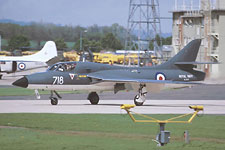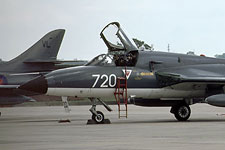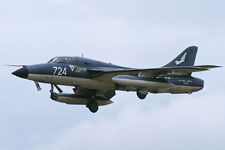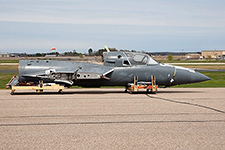 |
| HAWKER HUNTER T.8M XL603 - '724' |
| XL603's service history
Hawker Hunter XL603 was constructed by Hawker Aircraft Ltd at it Kingston-upon-Thames factory. It was flown on its first flight by David Lockspeiser on 6th December 1958, and was handed over to the Fleet Air Arm at RNAS Lossiemouth the following month.
Following preparation for service, it was issued to RNAS Yeovilton's Heron Flight on 12th February 1959 and coded '950' with a VL shore code applied on the tail fin. It remained at Somerset for the next three years, until it was moved to RNAS Belfast for extensive maintenance in March 1962. XL603 was transferred to MoD(PE) (Ministry of Defence Procurement Executive) charge at British Aerospace's (BAe) Brough plant on 30th June 1975. It was to be converted to T.8M specification for the Fleet Air Arm, where it was fitted with the Blue Fox radar as used in the Sea Harrier FRS.1, and also had half of its cockpit modified to that of a Sea Harrier. The aeroplane was operated on radar trials at RAE (Royal Aircraft Establishment) Bedford between October 1978 and April 1981, moving on to BAe's Holme-upon-Spalding Moor airfield the following month. Its trials work complete, XL603 was issued to 899NAS at Yeovilton, the Sea Harrier training squadron on 8th March 1983. Assigned the fleet number '718', the aeroplane received the 899NAS winged fist emblem on the tail fin by the end of the following summer. It was re-coded during 1984 as '720' and then again during 1988 as '724', and continued in 899NAS service until it was ferried to Hurn for a comprehensive overhaul in 1990. It subsequently retired to Yeovilton in the new dark sea grey colour scheme. It flew for the last time with 899NAS on 25th June 1993, and was placed in open store shortly after, acting as a spares ship for the active FRADU aeroplanes. It was offered for disposal at the November 1994 Sothebys auction. |
 [© Martin Morley]  [© Rob Schleiffert]  [© Ian Powell] | ||
|
|||
| | |||
XL603's civilian life The aeroplane was hammered down for £2,600 to Clive Forshaw, and it was moved by road to Bruntingthorpe airfield in Leicestershire. The aeroplane was placed on static display and was a popular attraction at the airfield's regular open days given its unusual appearance. During 1999, XL603 was sold to Global Aviation Inc, based at Tulsa in the USA and was dismantled at Bruntingthorpe and shipped over to its new home by sea during March 2000. In May 2020, the fuselage was photographed at New Richmond Airport, WI. - January 2021 |
 [© Steve Buckby]  [© Jeremy D. Dando] | ||
| | |||
| << Previous airframe | Next airframe >> |